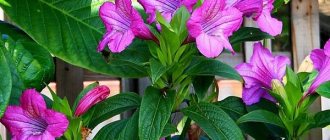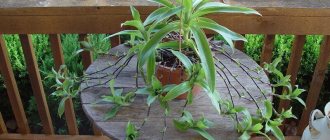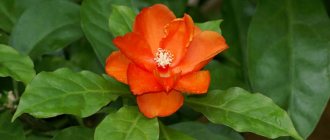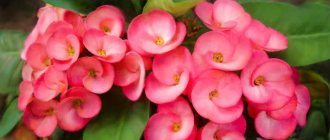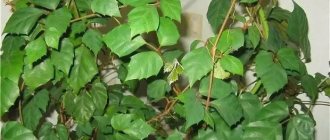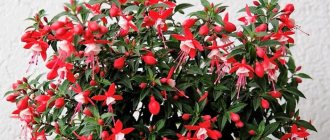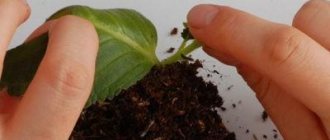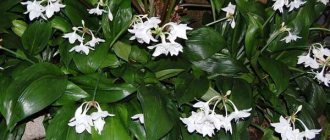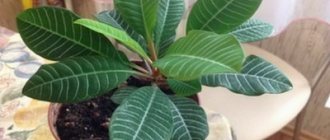Poliscias - beautiful bushes with amazing leaves
Poliscias is very popular among gardeners due to its elegant and very beautiful leaves. The genus belongs to the Araliaceae family and is characterized by great diversity. Sometimes it’s even hard to believe that such different plants can be related. Polyscias is widespread on the islands of the Pacific basin and in Central Asia. In our latitudes it is grown as an unpretentious indoor plant. It will definitely attract the attention of guests and become everyone's favorite.
Botanical description
The polyscias plant has a branched root system, which spreads equally in depth and breadth. Highly branched stems are located above the ground surface. They are covered with light brown bark and gradually become lignified. Surprisingly, even old branches have excellent flexibility. They are almost impossible to break, but can be tied into a knot and then straightened again. The lower part of the branches quickly becomes bare and the plant forms bushes with a spreading crown.
The leaves are attached to the branches by short petioles. Light or bright green, they can vary greatly in shape. There are types of polyscias with rounded, lobed leaves or narrow, pinnately dissected. The leaf blade can be glossy or leathery, and variegated varieties are also found.
Polyscias blooms with small capitate or umbrella inflorescences at the ends of young shoots. They consist of many small whitish flowers. Alas, it is almost impossible to achieve flowering indoors, so polyscias seeds are not used for cultivation.
Features of polyscias
The branched system of polyscias roots grows both horizontally and vertically. The heavily branching stems are covered with brownish bark. Over time, they become lignified, but they still remain very flexible: the stems are extremely difficult to break, but they can be tied into a knot and then straightened. As it grows, the lower part of the bush becomes exposed. Alternately arranged short-petioled leaf plates are painted in a rich or pale green color; they are round, lobed, triply pinnate or paired-pinnate, simply glossy or leathery. Polyscias has variegated varieties that are very popular among gardeners. While the bush is young, its foliage, as a rule, has a simple shape, but over the years it divides into segments. During flowering, inflorescences are formed on the bush, having a capitate or umbrella shape. But when cultivated indoors, such a plant blooms extremely rarely.
What is polyscias?!? )))) Poliscias fabian. Aralia fabian. My departure
Popular types
There are 80 species in the genus Polyscias. Among them there are tall and medium-sized shrubs, as well as small evergreen trees. The following types of polyscias are used in culture.
Poliscias Balfour. The plant is a low, highly branched shrub. The bark of young shoots is colored light green. The petiolate leaves have a round, lobed shape and bright color. Their diameter can reach 7 cm. The leaf blades have whitish spots and a border. Decorative varieties:
- polyscias Pinocchio - on large bluish-green leaves the veins are drawn in silver;
- Variegata - there is an uneven whitish border along the edges of the leaves.
Poliscias Guilfoyle. The large shrub is decorated with unpaired pinnately compound foliage. Notches are visible on the edges of the leaf plates. The color of the leaves is light green.
Polyscias fruticosa (fruticosis). A branched, low bush is covered with petiolate, carved leaves. The light green foliage is similar to fern fronds and has small jagged edges along the side edges.
Polyscias paniculata. The plant forms low-growing bushes, densely covered with light green leaves. The length of the pinnately dissected, soft leaves reaches 15-20 cm. There is a variegated variety with a golden narrow border along the edge of the leaves.
Polyscias fernifolia (folicifolia). The spreading evergreen shrub has lacy foliage 30-50 cm long. The leaf lobes fit tightly to each other and create a very strong resemblance to a fern.
Poliscias obtufolia. The plant has large dark green or bluish leaves. Dense leaves are located on long petioles. The shape of the leaf plate has rounded edges and a three-lobed division. There is some similarity between the leaves of this species and the foliage of oak.
Poliscias helmet-shaped. The plant has an unusual structure of the trunk and branches. The main stem is thick and strongly curved, and the young branches have a straight, vertical shape. The foliage forms a dense, spreading crown. Young leaves have a solid, rounded leaf blade. Older leaves have a three-lobed structure and a whitish border along the edge. The species is suitable for bonsai formation.
Polyscias curly forms low bushes. Leaves cover the shoots almost the entire height. The leaf blades have a round, double- or triple-dissected shape. The leaves are bright green and may be spotted with yellow or have a narrow white border.
Possible problems in growing
Pests settle on leaf blades and stems. The main ones include:
- mealybug, leaving traces in the form of lumps resembling cotton wool;
- aphid, which is a green small insect;
- scale insects of a brownish hue, hiding under the shell.
To get rid of these pests, you must first wash them off. After this, the plant is treated with a soap solution. As a last resort, an insecticide is used.
Shchitovka
Excessive watering can lead to rot. Replanting and pruning the affected areas will solve this problem. A sharp change in growing conditions will also negatively affect the health of the bush.
Reproduction and transplantation
Polyscias is propagated by rooting cuttings. This process is very painstaking. You can root young apical shoots or older, lignified branches. The former have a more neat and decorative appearance, but the latter take root faster. In early spring, cuttings 8-12 cm long are cut. The cutting areas must be sprinkled with crushed charcoal and dried for 3-4 hours. After this, the cuttings are slightly buried in the sand-peat mixture and watered. The pot must be covered with film or glass to create greenhouse conditions. The air temperature should be +25 °C. The greenhouse should be ventilated and the soil sprayed daily. Roots appear in 3-4 weeks.
Rooted cuttings and young plants are planted in small pots. The bottom of the container is lined with a layer of brick chips, clay shards or expanded clay. Land for planting should consist of:
- leaf soil;
- turf soil;
- humus;
- peat;
- river sand.
An adult indoor plant polyscias is replanted less frequently (every 2-3 years) using the method of transferring an earthen clod.
Reproduction of Poliscias
Breeding this plant is a rather complicated process; it takes a long time to take root. But experienced flower growers cope with this task. Moreover, the plant can be propagated in different ways.
Seminal
Seeds are sown in pre-prepared boxes with light soil and sprinkled a little on top. Seal with film and send to a dark place with a temperature of +19–25 °C. When the shoots appear, the film is removed and they begin to gradually adapt them to the light.
Cuttings
Planting material is harvested in the spring. Three internodes are left on each cutting. The sections are treated with phytohormone. It is best to root them in damp peat or a mixture of sand and peat.
The container is kept under film at a temperature of about +25 °C, constantly maintaining high humidity.
Note! Rooting cuttings is difficult and often unsuccessful.
Rhizome pieces
The roots of the old bush are cut into fragments 3 cm long. Then they are placed in a vertical position in a container filled with wet sand. The top is located at soil level. No cover required.
This video shows how to propagate Polyscias fruticosa Fruticosa.
Rules of care
At home, caring for polyscias does not require much effort. It is important to remember that the plant gradually grows and even in a room can reach a height of two meters. Therefore, it is worth choosing a convenient place for such a decorative giant in advance. In order for polyscias to form a beautiful crown, it is recommended to pinch the tips of the shoots and carry out periodic pruning.
Related article: Articles about replanting indoor plants
Poliscias prefers diffused light and slight partial shade. It can be placed in the back of a room with east or west windows. In northern rooms, lighting may be needed in winter, especially for variegated varieties.
The bushes need a moderately cool room, in which the temperature is maintained all year round at +17...+24 °C. A constant supply of fresh air is necessary, but drafts have a negative effect on the plant.
Polyscias should be watered frequently and in small portions. The top layer should dry out, but with prolonged drought, the leaves immediately droop and begin to turn yellow. Excessive watering is also bad; it provokes the development of root rot. Water for irrigation should be 1-2 °C warmer than the air.
Polyscias requires a room with high air humidity (70-80%). It is recommended to use trays with wet expanded clay, place pots near aquariums and fountains, and often spray the shoots. Periodic warm showers will also help. In winter, you should move the plant away from hot radiators or use glass to create a barrier to hot, dry air.
Poliscias needs fertilizer throughout the year. From April to October, fertilizing is applied twice a month, the rest of the time - monthly. Use universal mineral and organic compounds for decorative foliage indoor plants.
Difficulties in growing
The following problems may arise during cultivation:
- dropping leaves;
- worsening variegation of leaf blades;
- the appearance of a brownish tint on the foliage;
- the appearance of brown plaques and sticky plaque on the leaves.
These problems can be avoided if you follow all the recommendations for caring for polyscias and planting it.
The polyscias flower attracts gardeners with its appearance. Proper pruning and care will extend its lifespan at home.
Video
Planting and caring for polyscias
- Flowering: not observed at home.
- Lighting: bright diffused light for variegated species, light partial shade for green-leaved species.
- Temperature: during the period of active growth – 20-23 ºC, in winter – 17-20 ºC.
- Watering: in the warm season - moderate, but frequent, as soon as the top layer of the substrate dries. In winter, the soil is watered 2-3 days after the top layer of the substrate has dried.
- Humidity: high. The plant requires regular spraying of the leaves or maintenance on a tray with wet pebbles.
- Feeding: from April to October - once every 2 weeks with mineral fertilizer for decorative deciduous plants, and from October to April fertilizers are applied only once a month.
- Dormant period: not clearly expressed, but in winter vegetative processes noticeably slow down.
- Transplantation: at the end of March or at the beginning of April. Young plants are replanted annually, adults - once every 2-3 years.
- Reproduction: by stem and apical cuttings, less often by seeds.
- Diseases: root rot.
- Pests: scale insects, aphids, mealybugs, root nematodes.
When and how does it bloom
Mandevilla flower - home care
This culture practically does not bloom at home, unless in rare cases. By pruning, standard trees and bonsai are formed. In the wild, inconspicuous, light paniculate inflorescences appear. Flowering period is mid-summer.
The dormant period of polyscias is the end of autumn. During this period, the shrub needs minimal care. Spraying should be done 2 times a week. Abundant watering and fertilizing are not required. The most important thing is to prevent the temperature from dropping and drafts in the room.
Polyscias flower - description
Polyscias has a branched root system, spreading both vertically and horizontally. The shoots of the plant, covered with light brown bark, are also highly branched. Gradually they become lignified, but remain flexible even with age: they are very difficult to break, but can be tied in a knot and then straightened. Over time, the lower part of the polyscias becomes exposed. The alternate light or bright green leaves, located on short petioles, can be paired-pinnately dissected, triply pinnate or round, lobed, leathery or simply glossy. The plant has varieties with variegated foliage that are popular in indoor culture. In young plants, the leaves are usually simple, but as they mature they begin to divide into segments.
The polyscias plant blooms with medium-sized apical umbels or heads consisting of small whitish flowers, but at home flowering occurs very rarely.
Polyscias transplant
As mentioned above, the plant should be replanted annually in the spring. When the crop reaches the age of eight years, this procedure will need to be performed every three years.
When polyscias grows and reaches a large size, transplantation will become impossible. In this case, it will be enough to replace the top layer of soil mixture with a more fertile one. It is better to purchase soil at a flower shop.
However, you can make it yourself by taking garden soil, river sand and peat in a ratio of 2:1:1. Before planting, the soil must be disinfected by pouring boiling water over it. Expanded clay should be placed at the bottom of the pot to create a drainage layer. To avoid damage to the root system, replanting must be done by transshipment.
After the plant is transferred to a new container, the voids must be filled with new soil, lightly compacted and watered. Adaptation after the procedure takes about a month.
Caring for polyscias at home
Caring for polyscias in an apartment
The indoor polyscias flower, like its wild relatives, loves bright, diffused light, both during the season of active growth and in winter. It grows well in light partial shade. Variegated varieties need more light to maintain their original colors than plants with green leaves.
The most comfortable temperature for polyscias during the growing season is 20-23˚C. In winter, it is advisable to keep indoor polyscias away from heating devices at a temperature of 17-20 ˚C. If a flower pot is on a windowsill, protect it from the hot air rising from the radiator with glass or plastic, and place a piece of foam under the pot so that the roots of the plant do not freeze.
Poliscias loves fresh air, so ventilation of the room is mandatory at any time of the year, but drafts are contraindicated for the plant.
Watering and feeding polyscias
Water the polyscias often, but moderately, after waiting until the top layer of the substrate dries in the pot. In winter, after the substrate has dried to the specified depth, it is advisable to wait another 2-3 days before watering.
Polyscias, which requires high air humidity, must be sprayed regularly. And water and spray polyscias with settled water slightly warmer than room temperature. Hard water can be softened by adding a few drops of lemon juice or citric acid crystals. In order to increase air humidity, containers with water are placed around the polyscias. You can place the pot with the plant on a tray with wet pebbles or expanded clay so that the bottom of the pot does not touch the water. If you have an aquarium, place Polyscias next to it. From time to time it is advisable to wash the plant under a warm shower.
Indoor polyscias is fertilized from April to October twice a month with universal mineral fertilizers for decorative deciduous indoor plants, and from October to April, fertilizing is applied only once a month. Polyscias are also fertilized with organic solutions, which are sold ready-made in specialized flower shops.
Article on the topic: Crocus flowers: planting and care in open ground, photo, growing, when to dig
Polyscias transplant
Young polyscias are replanted annually, and adults - once every 2-3 years. It is better to replant in the spring, at the very beginning of active growth. The substrate for polyscias is mixed from equal parts of coarse river sand, humus, peat, turf and leaf soil. A thick layer of expanded clay or clay shards is placed at the bottom of the pot.
The plant is replanted using the transshipment method, for which the flower is well watered in advance so that it is easier to remove it from the pot along with the earthen lump on the roots. Polyscias is transferred to a new pot, after which the remaining space is filled with fertile substrate. After transplantation, the plant is watered and not fed with fertilizers for at least a month. When polyscias begins to actively grow, its shoots are pinched to stimulate branching.
Polyscias also grows well in hydroponics.
Reproduction of polyscias
Polyscias are usually propagated vegetatively at home: by stem and apical cuttings. However, the process of cuttings, which occurs without any difficulties in other plants, is not simple in the case of polyscias, since the cuttings of this plant take root difficultly and for a very long time. Sections of cuttings separated from the mother plant are powdered with coal powder, dried at room temperature, planted in a mixture of equal parts of peat and coarse sand and covered with a transparent cap to create increased air humidity. Keep the cuttings at a temperature of 25 ˚C, ventilating in the mornings and evenings, moistening the soil and spraying the cuttings as needed. Rooting lasts at least a month.
Reproduction methods
Cuttings
As a rule, apical or stem cuttings are used to propagate indoor polyscias. Many plants can be propagated by cuttings quite easily, but not polyscias. The fact is that if everything is done correctly, the roots on the cuttings can grow, but it will take a very long time. After suitable cuttings are cut, the cut areas are sprinkled with charcoal crushed to a powdery state. Let the cuttings dry at room temperature and only then plant the cuttings for rooting. To do this, they are planted in a mixture of coarse sand and peat (1:1), on top they should be covered with a transparent cap (for example, a bag or glass jar), in this case it will be much easier to maintain the high level of air humidity necessary for rooting.
Place the container with the cuttings in a warm place (about 25 degrees), do not forget to regularly ventilate in the morning and evening, if necessary, moisten the cuttings with a spray bottle and water them. They will take root for at least 30 days.
Pests and diseases of polyscias
Polyscias diseases and their treatment
All plant diseases arise from improper care. For example, due to dry air, polyscias leaves turn brown at the edges and fall off. The plant may shed its leaves due to too high a temperature, dry indoor air or drafts. Sometimes this process accompanies the natural aging of polyscias, and then you have no reason to worry.
Polyscias is very resistant to infections, but from chronic waterlogging the flower can be affected by root rot. What to do in this case? You need to remove polyscias from the pot, examine its roots, remove rotting areas with a sharp sterile instrument, capturing part of the healthy tissue, treat the wounds with crushed coal and transplant the plant into a fresh substrate. For some time it is better to water the flower with a solution of Fundazol or a pale pink solution of potassium permanganate until you are sure that the plant has recovered.
Polyscias pests and their control
A weakened or newly transplanted plant can be occupied by pests such as scale insects, aphids and mealybugs. All these insects feed on the cell sap of the plant, biting through its leaves and young shoots. Sucking pests are destroyed with insecticidal preparations, but scale insects and scale insects must be removed from the polyscias before treatment using a cotton swab soaked in alcohol.
Then the plant is washed in the shower, allowed to dry, and only after that it is treated with Aktara, Actellik, Decis, Fitoverm or another insecticide of a similar effect.
There are known cases of polyscias being affected by root nematodes, due to which the plant slows down its growth and development, begins to wither and eventually dies. Fighting nematodes is practically useless, so hurry up and cut cuttings from polyscias and root them. This is the only way to preserve the plant.
Types and varieties of polyscias
We offer you an introduction to the types and varieties of polyscias, which are most often grown indoors.
Polyscias scutellaria
An evergreen shrub-type plant with a curved, bonsai-like main trunk and erect, thin side branches. The numerous entire shiny leaves of this polyscias, green with a white edge, have a rounded shape when young, but with age they become three times dissected. Popular variety:
- Marginata is a plant with a wider white border along the finely toothed edges of green leaves.
Polyscias crispatum
A plant that forms low bushes. Its shoots are covered with leaves along their entire length. Bright green leaf blades with a white border along the edge, rounded in youth, over time acquire a double and triple dissected shape and can become covered with yellow spots. Popular varieties of the species:
- Palapala is a plant with yellow spots on green leaves;
- Raffles is a flexible plant with green leaves used for bonsai.
Polyscias fruticosa
The most attractive species grown in cultivation, reminiscent of a fern. Convex lentils can be seen on young shoots of the plant. The leaves of Polyscias shrub are vaginal, double and triple pinnate, with serrate-toothed leaves of different shapes along the edge - from round to lanceolate. Unattractive small flowers form apical inflorescences. The most popular in culture are:
- Multifida - a form with numerous linear-lanceolate and linear segments ending in light hairs;
- Filigree - a variety with finely dissected lacy leaves;
- Snow Flake is a polyscias with a white border along the edges of coarsely toothed leaves.
Polyscias balfouriana
Or Polyscias balfuoriana - a weakly branching evergreen plant up to one and a half meters high with dark green pinnately dissected lobulated leaves of an almost round shape, about 7 cm in diameter, with a white border and spots along the edges, located on long petioles. The best varieties:
- Fabian - a variety with dark purple leaves;
- Pennockii is a plant with larger, bluish-green leaves with silver veins than the main species;
- Variegata is a plant with an uneven whitish border along the edges of the leaves.
Polyscias obtusa
A species with complex leaves consisting of rounded three-lobed leaf blades, similar in shape to oak leaves, which is why in foreign literature this species is often called “Oak Leaf” (oak leaf).
Polyscias filicifolia
An evergreen shrub with fern-like long green pinnately dissected leaves 30-50 cm long with densely spaced lobules.
Polyscias paniculata
A low-growing shrub with densely growing pinnately dissected light green leaves 15-20 cm long. Most interesting:
- Variegata variety is a plant with a narrow golden border along the edges of the leaves.
Polyscias filicifolia
A very spectacular, low-branching species with large bright green openwork leaves reminiscent of fern fronds.
Related article: Hawthorn plant: planting and care in open ground, photos, beneficial properties and contraindications
Polyscias guilfoulei
A popular cultivated branched shrub with large unpaired pinnately compound leaves consisting of jagged oval-lanceolate green leaves with a white or yellow edge. The most beautiful varieties:
- Variegata is a variety with yellow-green leaves;
- Victoria is a plant with small white-green leaves, heavily cut at the edges;
- Black - a variety with dark green wrinkled leaves;
- Smooth Black is a polyscias with very dark, smooth leaves.
General information
Poliscias belongs to the Araliaceae family. Related species are ivy and fatsia. Its homeland is the Pacific Islands.
- It looks like a low tree or small shrub with vertically directed branches.
- The stem becomes covered with brown bark as it grows, but retains its flexibility. The branches are almost impossible to break, but easy to bend and straighten again.
- The leaf blades are varied in shape and color. They are attached to the branches with short petioles. Particularly popular are species with variegated leaves and carved edges.
- Interestingly, young plants mostly have a single leaf blade. Over time, their edges separate and take on bizarre shapes.
- Over the years, the lower third of the trunk loses branches and leaves, and polyscias becomes bonsai-like.
- The root system is highly developed, growing both in depth and in width. Therefore, you will need a voluminous pot.
Types and varieties
About 100 species of polyscias are known in nature. Most of them are also grown at home. Flower growers value varieties with variegated colors or patterned leaf shapes.
Polyscias fruticosis
Polyscias shrub is strewn with carved leaves. The color is uniform, green, and different shapes of plates can be distinguished on one plant.
We love gardeners for their best adaptability to the home microclimate. Can grow well in partial shade and tolerate short droughts.
Poliscias curly
A very compact plant without a tree-like trunk. Depending on the variety, there are rounded leaves dissected into 2 or 3 segments.
The green color is rich, and variegated varieties may have yellow splashes or a border.
Poliscias Balfour
Poliscias Balfour is a low-growing shrub. Its branches are covered with green-gray soft bark. The leaf blade is 7 cm long and consists of 3 segments that together form a semicircular shape. Their color depends on the variety: green with silver veins or a white border around the edge.
Poliscias Guilfoyle
It looks like a shrub with oval leaves. On the shoot they are located opposite each other. The edges of the plate have pointed teeth.
Polyscias paniculata
Low shrubs with feathery leaves. Their coloring is interesting: against the main green background, yellow specks can be seen around the veins.
The species is very sensitive to lighting - with a lack of it or an abundance of direct sunlight, the color becomes monochromatic.
Polyscias fernifolia (folicifolia)
The leaves of this species are elongated with long and pointed teeth. The petioles on the branch are closely adjacent to each other, reminiscent of a fern. Together the leaves form a beautiful openwork pattern.
Poliscias obtufolia
The blunt-leaved species has fleshy leaves of a dark green color. The edges of young plants are solid, round in shape, and with age they are divided into segments with notches. The surface of the leaf plate is covered with a thin waxy coating, giving it a glossy shine.
Poliscias helmeted
At the beginning of growth, it has erect stems that bend with age. The leaf plates are round in shape, the edges of which are curved like a helmet. Over time, they separate into 3 segments. Due to its rapid growth rate, Polyscias helmet requires frequent pruning and crown shaping.
Polyscias aculifolia
The feathery leaves resemble a fern. They are located opposite each other, and each individual plate is cut into pointed segments almost to the base.
The color is in bright light green tones, with a waxy sheen visible on the surface.
Poliscias marginalata
The marginata species is distinguished by its semicircular leaves with small teeth along the edges. Their main color is green, with white inclusions visible along the contour.
The main trunk bends, and thin shoots (straight and short) end in leaf blades.
Caring for polyscias at home
Poliscias is not often found on window sills - caring for it causes a lot of trouble. You need to please your capricious pet in each of the microclimate parameters.
Location and lighting
All types of polyscias prefer bright and diffuse lighting. Without sufficient intensity and duration, growth slows down significantly or completely stops, and the color of the leaves turns pale. South-east or south-west direction will be the best option.
Direct sunlight is also not suitable for the plant. In hot summer time, the window on which the flower is located should be covered with tulle or mesh. In winter, on the contrary, it is recommended to turn on additional phytolamps in the morning and evening hours.
Temperature
Polyscias is sensitive to both excessively high temperatures and hypothermia.
The maximum thermometer reading should not exceed 24 °C, and in winter it should not be allowed to drop to 17 °C. The optimal range is recommended within 20...22 °C at any time of the year.
In winter, you especially need to worry about the temperature regime, because the plant will be cold on the windowsill, and the air near the window and radiator will be too hot. The best solution would be to place the flower on a stand inside the room with artificial lighting.
Air humidity
Most species require high humidity. A tray covering the entire width of the window sill, into which wet pebbles are poured, is ideal for this. A pot with a plant placed on it will absorb evaporating moisture in the required quantity.
Some varieties, such as Poliscias pinocchio, still require additional spraying. The procedure is carried out daily, and in the summer – twice a day.
Periodic washing of the leaves in the shower to clean the surface of dust is useful (once every 1–2 weeks).
